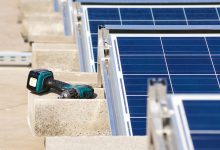The growing complexity surrounding connections to the main grid is causing more contractors to abandon the large scale solar sector, and to a lesser extent wind, with some warning that the industry faces a potential contractor shortage and higher prices because of it.
RenewEconomy revealed on Wednesday that listed contracting giant Downer Group announced a dramatic exit from the solar contracting business, saying the business had become too hard because of changes and the complexity of grid connections, and it was no longer worth the risk. “We’re out of solar,” Grant Fenn said.
That followed the dramatic collapse in 2018 of its listed rival RCR Tomlinson, which crumbled under the weight of cost over-runs and delays at around one dozen large-scale solar farms, many of them in Queensland. Other contractors have also been hit by cost blowouts and claims of “liquidated damages”.
It now emerges that Downer is not the only contractor to quit the market. Other big and small contractors have also exited the solar industry, at least in part. The listed Decmil, which last year revealed problems at the Sunraysia solar farm in NSW, is no longer accepting “full EPC wrap” contracts. It may do part of the job, but it is not doing the full project.
Like Downer, it has been driven away by the complexity and “muddied waters” – as some have described it – of changed connection rules, some of which have been driven by knee-jerk reactions by regulators and rule-makes to the South Australia blackout in 2016.
Even the Australian Energy Market Operator has admitted that some of these rules – including the “do no harm” requirement that puts the onus on last in generators to maintain system strength – are being counterproductive and inefficient because in some cases it has actually made grid reliability worse rather than better. That view is echoed by some grid owners.
Other contractors are also thought to be out the door from the solar industry. This includes Tempo Services, a small listed contracting company that ran into trouble soon after accepting its first solar contract, the Cohuna solar project in Victoria. It is now run by the ex RCR Tomlinson chief Paul Dalgleish and is not looking for new solar contracts.
Industry sources also say that UGL, involved in the Bannerton solar farm that is one of five such projects heavily constrained by new AEMO rules, and Biosar have also been absent from recent tenders and may have left the market. RenewEconomy has sought confirmation from both companies but has not received a reply.
This leaves a diminished number of solar EPC contractors in the Australia market, such as Signal Energy, Sterling & Wilson, Bouygues, Beon, Gransolar, and Elecnor.
RenewEconomy wrote more than a year ago about the desire by some contractors to try to “share the risk” over connection delays and complications. See Who should hold hot potato of connection costs for wind and solar farms?
This is designed to try to arrest the growing number of cases where “liquidated damages” are sought to cover the lost revenue from project delays. A bitter case between Windlab and contractors on its world-leading wind, solar and battery storage project at the Kennedy Energy Hub, has headed to arbitration and the courts, although a temporary “truce” has now been called.
Ironically, legal firm Norton Rose Fulbright issued a statement on Friday advising on its role in advised Signal Energy on its engagement as the engineering, procurement and construction (EPC) contractor for the 149MW (peak) Glenrowan West solar project in Victoria.
Emanuel Confos, a partner in the law firm and Australian head of construction and engineering, said the highlight of this deal was the “collaborative approach of the parties in sharing the procurement risks and the uncertain grid connection risks that face all renewable projects today.”
This is likely to become a feature of the market going forward, but it also highlights the elevated risks for project developers. In Victoria solar farms have had their output halved – in some cases years after they started production – because of system strength issues that have also caused other projects to have their commissioning delayed, and others warned not to bother constructing until a new transmission link is built.
Brett Redman, the CEO of AGL whose solar and wind farms near Broken Hill have been hit hard by the system restraints, as well as declining marginal loss factors, warned that renewable energy projects were being “choked” by the worsening connection issues, and only the “very best” were getting ticks of approval from investment committees.
Signal Energy only entered the Australian market in January 2018, and has also completed the 133MW Finley solar farm and is building the 275MW Darlington Point solar and storage project, both in NSW.










